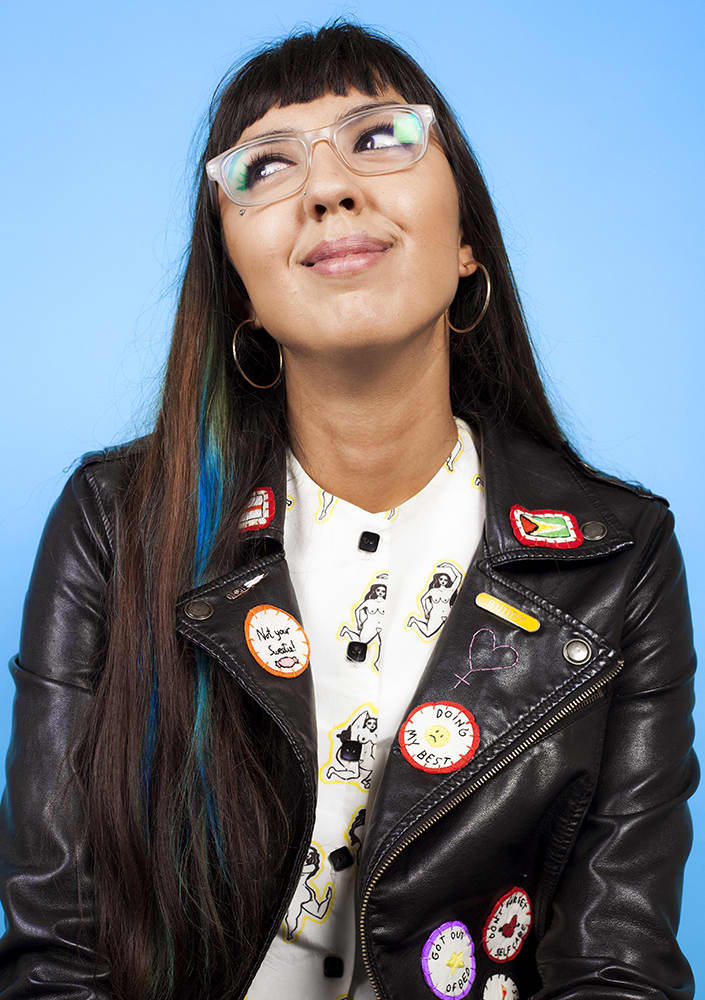Get To Know The Feminist Embroiderer Behind The Best Arthur Meme On The Internet
British fine art student Hanecdote uses witty needlepoint to share a serious message.

Most memes, it’s safe to assume, don’t take more than 15 minutes to create. But my favorite one lighting up news feeds right now is an image that was hand-stitched, painstakingly, over the course of 15 hours by London fine art student Hannah Hill, aka Hanecdote. It’s a cute twist on the “Arthur’s fist” meme, and the fact it took so long to create only cements the punchline: that embroidery, despite being sidelined as “women’s work” for centuries, requires a ton of skill and effort.
Hill is a 22-year-old who is in her third year of studying fine art at City & Guilds art school in London, and is outspoken about mental health and body positivity on her Twitter and YouTube channels. The needlework she posts on her joyful Instagram feed gives an insight into her life and feminist beliefs. Her subject matter roams between self-portraits, grime fan art, weed paraphernalia, positive affirmations, and now, memes. The FADER caught up with her on Skype to find out why she chose the needle and thread as her medium, and how she channels self-love and feel-good vibes into her stitches.
Why embroidery?
My mum has always sewn and knitted, so I've always had it around me, but I had never tried it until college [at 17]. When I did try it, I became obsessed. I think it’s because you can undo stitches, whereas with a pen it's more permanent. As I learned to sew, I then realized the history of embroidery, in the sense that it was seen as sort of a domestic hobby. It wasn't really taken seriously in the art world. Learning about the history of needlework, and also being a feminist, those two things tied in and made me feel empowered. I feel very grateful that I live in a time where I'm able to express myself through a medium, whereas for the past couple hundred years women haven't been taken seriously through that medium.
I’ve found out about a lot of great male and female people that work in textiles, and with the emergence of social media, all of these artists are being able to have their work shown, create communities, and build followings. [But] the most famous textile artist right now is a man, Grayson Perry. It's sort of like every other industry: women are meant to be homemakers and in the kitchen, but the top chefs are men. Same with fashion, and the art world.
Does doing embroidery make you feel connected to previous generations of women in your family?
Definitely! My mum's from Guyana in South America. [And my nan is] the oldest of nine siblings. When she was growing up it was like, you either learned to cook, or textile skills, so she became a seamstress, making clothes and garments. I've always felt like the black sheep of the family, but having that textiles connection, it’s like a bridge [between us].
Your work explores a lot of subjects that might seem unusual or even taboo for embroidery. Periods, for example.
I really like the juxtaposition of things. The medium is very much thought to be dainty, pretty, delicate, soft, all of these things. There's great embroidery that fits into that category. But I enjoy playing. Also, a lot of my work is autobiographical. I guess it just so happens that my work kind of contradicts, or doesn't fit exactly with the medium. A new piece that I'm working on [is] inspired by London and grime, it's very much a subject matter that's outside of my comfort zone.
Have you always been into grime?
I'd say for about six or seven years. From secondary school.
Who are your favorite grime artists?
Skepta, just as far as what he's done for the scene. He's been so inspiring to me as an artist, with him talking about authenticity and activism and having your voice heard. I am so happy to live in a time where there are people like Skepta, who is so politically active — Novelist as well — inspiring their following to become engaged. Our generation and younger have been really shat on by the government. We're not really respected; they're making us pay X amount for our degrees, services have been cut...I think [Skepta and Novelist] inspire countless people. I love Frisco and AJ Tracey. Nadia Rose doesn't class herself as a grime artist, but I just love what she's doing right now.
You celebrate body positivity a lot on Instagram and in your work. What’s your journey been to loving your own body?
Sometimes I have to make myself uncomfortable in order to post something online. I think with some selfies, it's so easy to just stare at it and criticize yourself and be like, Oh my god, that bit of fat or that bit of hair. Sometimes I just post it before I have time to criticize and funnily enough, those are the times when I get nice responses from people. So that's kind of like a cycle of encouragement. It's tiring hating yourself. I still really dislike myself in a lot of ways, partly due to mental illness, partly just due to society wearing us down. But knowing that I've inspired other people, that blows my mind and really makes it worth it for me.
I like to fill my Instagram feed with great body-positive women, and you’re one of my favorites. Who do you follow that makes you feel good?
The first person that came to mind was Frances Cannon, who has sort of gone viral with her “Self Love Club” tattoo idea, which I think a lot of women around the world have been getting. She posts pictures, and her drawings and artwork, which is mainly body-positive, [about] being kind to yourself, that sort of thing.
Your embroidery incorporates weed and smoking quite a lot. Is that a challenge to the stereotype that smoking can't be feminine, or that women can't be stoners?
Yeah! But I think because most of my work is so autobiographical, some of these things have happened by accident. There’s a lot of negative propaganda surrounding weed smokers. A big part of my life is smoking weed; a big part of me coping with mental illness is being stoned.
Does embroidery help you work through mental illness too? It must feel good to break away from screens, and to do something with your hands.
It's a good point. Someone tweeted at me [in response to the Arthur meme] saying, "What's the point? You could Photoshop this.” I just thought, That's really bizarre, you could say that about any art form. Yeah a machine can do it, or a program can do it. But that's not satisfying. I enjoy the process. [It can be] very relaxing, it's very meditative and calming. Even if I have doubts or concerns throughout the piece, by the end of it I'm extremely proud. Knowing that I've done every single step by my own hand, it's very satisfying to me.




